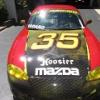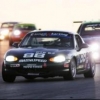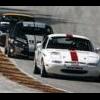
Effect of sways on corner balance
#1

 Posted 03-20-2011 05:24 PM
Posted 03-20-2011 05:24 PM

When I got the car on the scales I noticed that my cross weight had changed from 50% to 48%. I soon learned that the sway bars had a significant amount of pre load in them. After I reinstalled the end links with no tension things cleared up. It is amazing how much that can change things.
Also I set my ride height at 4 5/8 and put zip ties on the shock shafts to see where I am on suspension travel, I did take the car for a spine around the neighborhood, it looks like I am pretty close to the top of the shock. Anyone do this?
Frank
TnT Racing
SCCA Ohio Valley Region




#2

 Posted 03-21-2011 10:07 AM
Posted 03-21-2011 10:07 AM

Sounds like you are well on your way to learning the "secrets" to a well setup SM. Goodluck!
#3

 Posted 03-21-2011 06:43 PM
Posted 03-21-2011 06:43 PM

I don't know that driving around the neighborhood will calibrate the bump stop clearance very well, as you aren't putting the cornering load on the suspension.
If you want to be gentle on the bump stops, measure a gap of 5/8-3/4" between the top of the shock and the bump rubbers. You can try to calibrate your finger (common method) to stick up there, or bend a coat hanger wire to that size and stuff it up under there to verify the gap.
-Juan
CheckerLap.com -- Your race results!




#4

 Posted 03-21-2011 06:55 PM
Posted 03-21-2011 06:55 PM

Frank,
I don't know that driving around the neighborhood will calibrate the bump stop clearance very well, as you aren't putting the cornering load on the suspension.
If you want to be gentle on the bump stops, measure a gap of 5/8-3/4" between the top of the shock and the bump rubbers. You can try to calibrate your finger (common method) to stick up there, or bend a coat hanger wire to that size and stuff it up under there to verify the gap.
-Juan
I agree that the ride around the neighborhood will not equal loading the car on the track but that was my concern just that little run I was almost to the top of the shock
Juan, is the measurement you gave me 5/8 to 3/4 the measured gap from the rubber spacer to the top of the shock hats, the same if you using fat cat bump stops? That does not seam like much. I will have to get under there and take a look.
Frank
TnT Racing
SCCA Ohio Valley Region




#5

 Posted 03-21-2011 07:10 PM
Posted 03-21-2011 07:10 PM

I agree that the ride around the neighborhood will not equal loading the car on the track but that was my concern just that little run I was almost to the top of the shock
Juan, is the measurement you gave me 5/8 to 3/4 the measured gap from the rubber spacer to the top of the shock hats, the same if you using fat cat bump stops? That does not seam like much. I will have to get under there and take a look.
Frank
That height works well and Juan is right, however, after your first session, every one of the zip ties will be buried at the stop
Jim
East Street Auto Parts
Jim@Eaststreet.com
800 700 9080













#6

 Posted 03-21-2011 07:16 PM
Posted 03-21-2011 07:16 PM

Frank
That height works well and Juan is right, however, after your first session, every one of the zip ties will be buried at the stopYou will get to them, you just don't want to bounce off them violently
Jim
Thanks Jim I plan on experimenting with my set up this year since I have the scales to play with. I have the car now set up at 50% cross weight. Do you ever use wedge to tune your car and if so how much and when. Frank.
Frank
TnT Racing
SCCA Ohio Valley Region




#7

 Posted 03-21-2011 07:28 PM
Posted 03-21-2011 07:28 PM

Every Monday night at 8pm est we have live chat in the chat room, Drago and Collins were there tonight to answer our question on about any topic.
J~








#8

 Posted 03-21-2011 07:49 PM
Posted 03-21-2011 07:49 PM

Thank Jim I plan on experimenting with my set up this year since I have the scales to play with. I have the car now set up at 50% cross weight. Do you ever use wedge to tune your car and if so how much and when. Frank.
You can use wedge to impact handling some. As for the ride height, you'll get several opinions on that. Mine is that you're just a bit too low. At that height you may be pushing hard on the bumpstops in some corners at some tracks (particularly the front). When you do that your spring rate goes through the roof. Once the bumpstops compress about 1/4 inch, they get VERY hard. I'd say you might want to increase height by 1/8 or so. Others may disagree. It's tough to know where you are on the bumpstops even with zip ties and if you're hitting exit curbs the zip tie measurement becomes meaningless.




#9

 Posted 03-22-2011 11:30 AM
Posted 03-22-2011 11:30 AM

Like Jim says, those zip ties will be buried in the bump rubbers after a typical session. The reason is that unless your car is set up like a dune buggy, the bumps and berms will exercise the suspension all the way to the bump stops. The right way to use the zip tie method is to run a couple laps staying off the berms and any significant bumps, then check them. This will tell you your suspension travel in the corners, vs. on the berms. You only need to run one or two laps.
Why do you want to know the travel in corners, not the berms? Because what you are trying to control is change in spring rate mid-corner that occurs if you hit the bumps when the car leans over. If you set down on the bump stop in the corner, the spring rate goes through the roof and causes that tire to lose traction. If it's the front tire, the car will push, and if the back, the car will get loose. These conditions are generally suboptimal, especially when the change happens mid-corner.
The problem with using ride height on the chassis is that there are many factors that affect the bump clearance at any given ride height: 1) different bump stop/hat combinations have different clearances, 2) tire diameters, 3) inflation pressures, 4) chassis twist. Better to measure directly what you are trying to set: the bump clearance.
Stay off the bumps, and the car will be well behaved and easier to drive. It will also respond sensibly to sway bar and ride height adjustments that you make to change balance.
-Juan
CheckerLap.com -- Your race results!




#10

 Posted 03-22-2011 12:44 PM
Posted 03-22-2011 12:44 PM

It makes allot of sense to me. I had another post earlier about were exactly I should take the ride height measurement off of the rail. the answer I came away with was that it was not that important where you took the measurement but to use the same point every time. I ended up using the pinch point of the jack perch area. What you are saying makes the most sense meaning you want the ride height as low as possible until you get into the bump stops so why not take your measurements from the bump stops. That is why I started playing with the zip ties. So I will check to get the measurements from the top of the shock under a static load. So I will start with that value then work from that point to make the car level. Thanks for the tips.Frank,
Like Jim says, those zip ties will be buried in the bump rubbers after a typical session. The reason is that unless your car is set up like a dune buggy, the bumps and berms will exercise the suspension all the way to the bump stops. The right way to use the zip tie method is to run a couple laps staying off the berms and any significant bumps, then check them. This will tell you your suspension travel in the corners, vs. on the berms. You only need to run one or two laps.
Why do you want to know the travel in corners, not the berms? Because what you are trying to control is change in spring rate mid-corner that occurs if you hit the bumps when the car leans over. If you set down on the bump stop in the corner, the spring rate goes through the roof and causes that tire to lose traction. If it's the front tire, the car will push, and if the back, the car will get loose. These conditions are generally suboptimal, especially when the change happens mid-corner.
The problem with using ride height on the chassis is that there are many factors that affect the bump clearance at any given ride height: 1) different bump stop/hat combinations have different clearances, 2) tire diameters, 3) inflation pressures, 4) chassis twist. Better to measure directly what you are trying to set: the bump clearance.
Stay off the bumps, and the car will be well behaved and easier to drive. It will also respond sensibly to sway bar and ride height adjustments that you make to change balance.
-Juan
Frank
TnT Racing
SCCA Ohio Valley Region




#11

 Posted 03-22-2011 12:57 PM
Posted 03-22-2011 12:57 PM

#12

 Posted 03-23-2011 11:23 AM
Posted 03-23-2011 11:23 AM

Short answer, yes, depends on the track!Thanks Jim I plan on experimenting with my set up this year since I have the scales to play with. I have the car now set up at 50% cross weight. Do you ever use wedge to tune your car and if so how much and when. Frank.
Glenn Murphey, Crew Chief
Owner Crew Chief Services The Pinnacle of Excellence, Contract Crew Services for the racing community.
Soon to be back in the club racing scene for good ![]()



1 user(s) are reading this topic
0 members, 1 guests, 0 anonymous users




 Sign In
Sign In Create Account
Create Account



 Back to top
Back to top Report
Report








